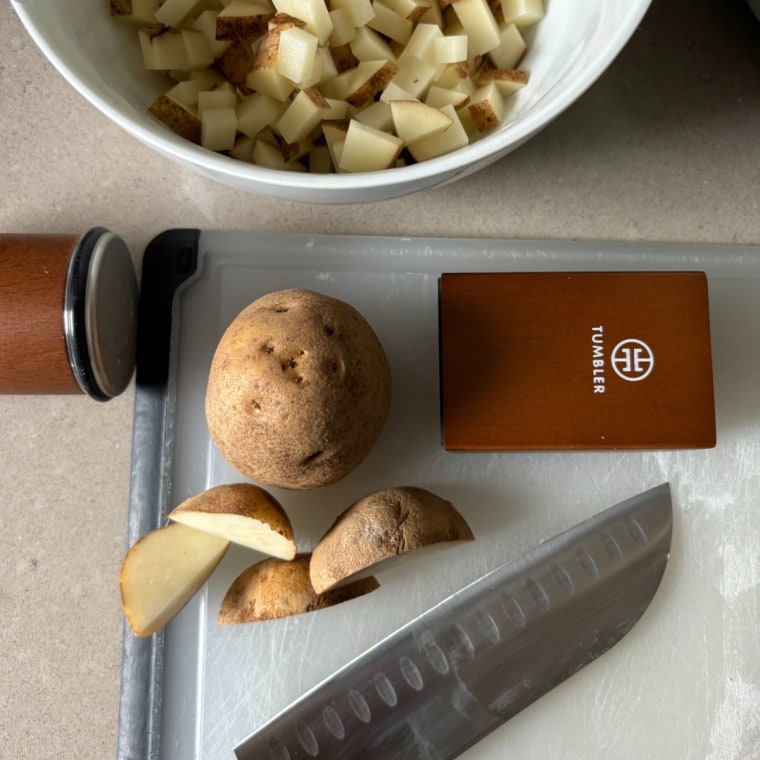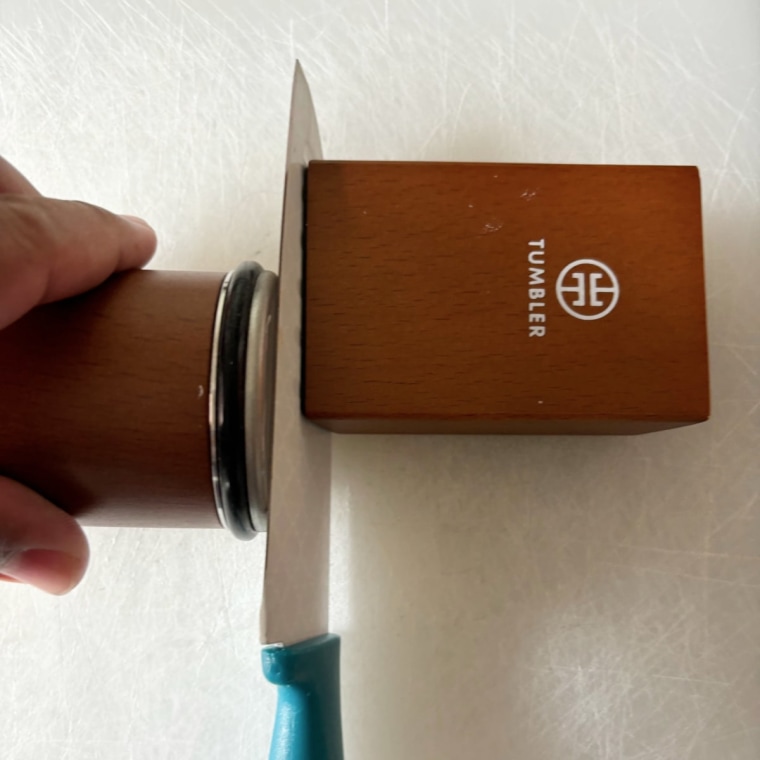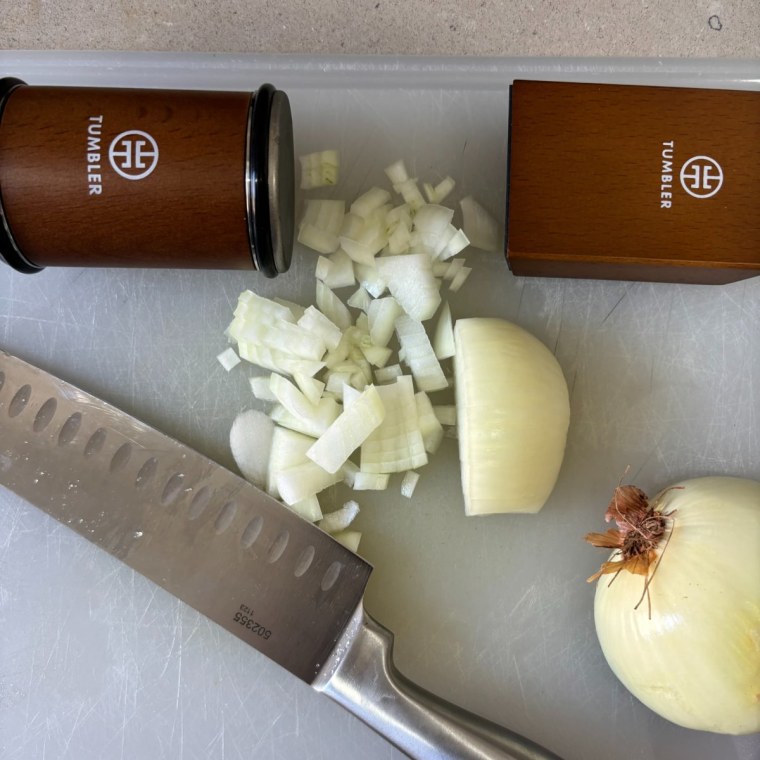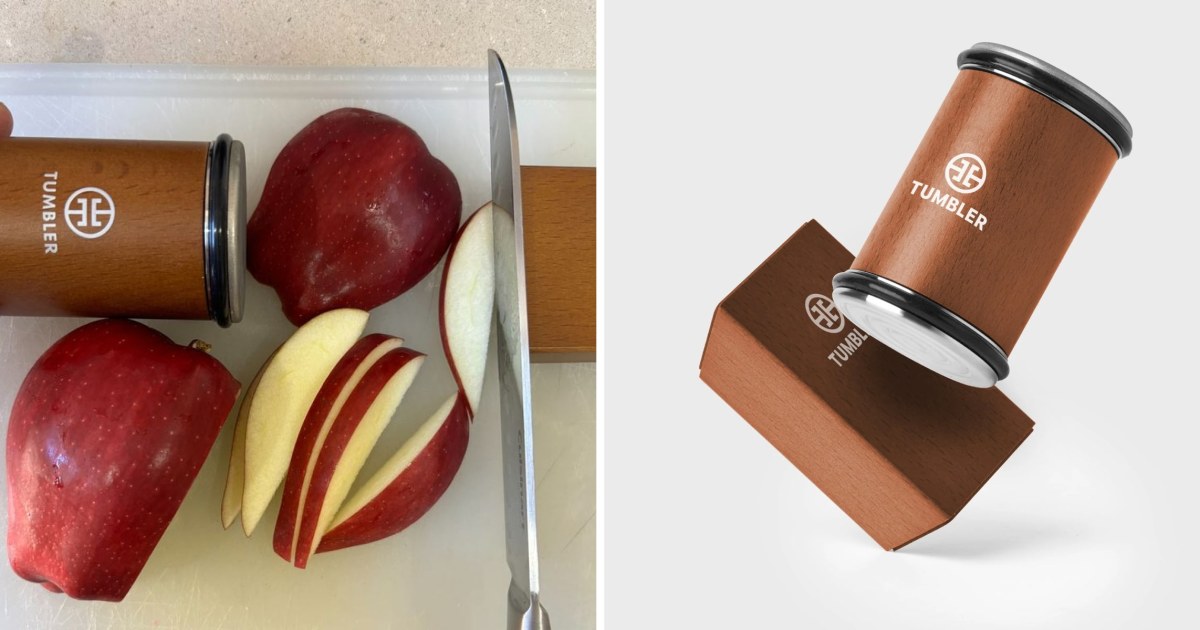As someone who cooks at home regularly, I stand by the idea that the most dangerous tool in a kitchen is a dull knife. Regardless of your experience level, a dull knife makes it easy to accidentally cut yourself when you’re dicing things like onions or tomatoes. And while a super sharp knife also requires careful use, it’s less likely to slip and more likely to cut through food with little effort.
That’s why having a sharpener, like the Tumbler Knife Sharpener, is so valuable. It can make sharpening your cooking knives at home safe, easy and approachable, especially if you’re not experienced with knife maintenance. I tried the Tumbler sharpener for about a month, using the tool to sharpen knives for cutting meat, vegetables and fruit. Below, I walk through my experience sharpening both new and dull knives, and whether the Tumbler gadget actually works well.
SKIP AHEAD What is the Tumbler knife sharpener? | How I tried the Tumbler knife sharpener | My experience with the Tumbler knife sharpener | Who is the Tumbler knife sharpener best for? | Why trust NBC Select?
What is the Tumbler knife sharpener?
Tumbler Knife Sharpener
The Tumbler knife sharpener ($129) is a manual knife sharpener with two components: a two-sided rolling disc and a magnetic, angled sharpening block. While some popular knife sharpening models require you to hold the knife yourself, either using one or both hands, the Tumbler knife sharpener uses magnetism to steady the blade of the knife onto the sharpening block so you can free up your hands to roll the sharpening disc and the other to hold the angled block.

The block has two magnetic sides, one angled at 15 degrees and the other at 20 degrees. The smaller the degree of the angle, the sharper it makes the blade. The rolling disc has two sides, a diamond stone that does the sharpening and a helix disc that helps smooth the blade after sharpening, according to the brand. After you sharpen the knife, the edge of the blade gets slightly gritty, so the helix disc helps remove that and refine the edge.
The brand also sent me its Companion Strop ($29), which is a flat rectangular piece of wood covered in a thin layer of leather that you use to clean off any residual bits leftover from grinding and sharpening, according to the brand.
How I tried the Tumbler Knife Sharpener
In addition to being a home cook who regularly prepares foods like onions, potatoes, celery, carrots, I’m a former recipe editor and food writer, so I have experience with precise knife work and quality cutlery. I also know the right angle to cut produce at and how to place my fingers on food to prevent injury.

Before sharpening any of my knives with the Tumbler, I made sure to cut through basic foods like potatoes, apples and plastic food packaging with my knives so that I could have a reference to compare the blade’s precision to after sharpening. To test the Tumbler, I used a basic chef’s knife from Cuisinart that was relatively new and affordable (less than $20). I also used it on an old (but different variety) Cuisinart chef’s knife, a Cuisinart paring knife and a chef’s knife from Farberware. I wanted to compare how effective the Tumbler was on knives of different ages and qualities to see what difference, if any, it would make.
When I was ready to start sharpening, I set up the 20-degree angle on the sharpening block first. The blade connects securely to the angled side (which has the degree written on it) because of the strong magnetism. The sharp end of the blade faces upward and lays vertical and flush with the countertop. Since I’m left handed, I steadied the angled block with my right hand and used my left hand to place the rolling disc adjacent to the blade and rolled it back and forth to sharpen it. I then flipped the knife to do the same on the other side. I used the honing helix disc to refine the sharpened edge.
I repeated this for at least 5 minutes at a time for each knife since the brand recommends sharpening for at least 3 to 5 minutes, though you can do it for longer depending on how dull the knife is and how sharp you want it to be.

Cory Fernandez / NBC
After sharpening, I used the strop to clean up and smooth the blade of the knife and made sure to rinse the edge of the blade and wipe it clean with cloth to let it thoroughly dry. I followed these clean up steps each time I tested the Tumbler knife sharpener.
To complement my personal experience with the Tumbler Knife Sharpener, I brought it into the office for my co-workers to try it out themselves. I had them cut through apples and lemons with their dull knives prior to sharpening, and then I showed them how to use the sharpener. I wanted them to have a sense of how sharp (or not so sharp) their knives were prior to using the Tumbler, so they could have a better idea of how much of a difference it made.
My experience with the Tumbler knife sharpener
The Tumbler knife sharpener makes a task that may seem intimidating to some home cooks, more approachable. The magnetism feature sets it apart from other models on the market, plus helps prevent injuries. That said, it’s not perfect. Below, I walk through my experience testing it in-depth.
What I like
Maintains pre-sharpened knives
I found the Tumbler most useful for keeping already sharp knives very sharp and in tip-top shape as compared to reviving old, dull ones. It helped maintain the sharpness of my new Cuisinart and didn’t make it crooked or rigid, and didn’t scratch or mess up the blade. For example, when slicing hard foods with coarse skins like russet potatoes and sweet potatoes (which I cook a lot) my newly sharpened Cuisniart chef’s knife was easy to run through the potato and not noticeably bent or scratched over the course of weeks, which is something I’ve noticed in the past with other knives when they go unsharpened.
In my experience, both the frequency with which you use a knife and what you cut with it can impact how effective it is over time. Certain foods like onions and bell peppers, don’t have super tough skins or cores, but root vegetables, like sweet potatoes, have tough flesh that can force your knife to be overworked. Something like the Tumbler makes it easier to ensure your new knife cuts just as smoothly the fifth week as it did the first.
If you don’t have a place to go get your knives sharpened by a professional and/or if you don’t want to keep replacing them every few years, having the Tumbler on-hand is very useful.
Strong magnetism
A unique feature of the Tumbler is that it uses magnetism to hold the knife in place against a sharpening block. Typical knife sharpeners require you to manually rub the knife against a whetstone or sharpening steel. This makes it harder to do correctly if you’re not familiar with the practice. Plus, the magnetism on each side of the angled block is extremely strong. This means that I didn’t worry much about whether or not the knife would fall off or move while I was sharpening it, which would otherwise lead to me getting cut. The magnetism also eliminated my need to hold the knife, which I would normally do with other manual sharpeners, such as a whetstone or a honing steel. This feature makes it easier for people with dexterity issues to sharpen their knives, too.
Easy to store
Since the Tumbler only really includes the roller disc (which is around the width of a can of hairspray and only a few inches tall) and the angled block (the size of a wallet), it’s easy to store in either the small box the pieces come in, in a small pouch or a plastic food storage container in your pantry or cabinet. The rolling disc weighs 1.4 pounds and the block is lighter than an 8-ounce can of soda. Both sides of the rolling disc are smooth and don’t scratch surfaces it comes in contact with. When I wasn’t using it, I kept it in the box it came in on top of my food scale in a cabinet.
Easy to learn
The directions and online instructions are very straightforward, which makes getting started very easy. I didn’t feel like I needed to be a professional chef or knife sharpening to try and use it. The small instructional booklet uses illustrations to show you how to hold and motion the Tumbler, so I didn’t have to wade through tons of heavy technical copy.
Potential drawbacks to keep in mind
Less effective on older knives

After testing, I found that the Tumbler seems less effective on older knives, and is better suited to keep sharp knives sharp. I used it on three different old knives and initially sharpened them for the recommended 5 minutes. I then used them to cut through foods like root vegetables and didn’t immediately notice a difference in how hard I had to press the knife into the sweet potato. In fact, I still had to briefly use two hands to get the older knives to cut fully through it.
After the initial sweet potato test, I went back to sharpening all of the old knives again for another 5 minutes each in hopes of getting the knives in better shape. I tried cutting russet potatoes and sweet potatoes again and still didn’t notice much of a difference. The dull knives didn’t cut through the firm center significantly faster or easier than before. I followed the entire process once more with the two dull knives and a sweet potato. After those three sessions, I noticed a subtle increase in sharpness and that the blade went through the sweet potato faster, but it still wasn’t a huge difference.
To validate my experience, I brought the Tumbler into the office and had three of my coworkers test it. They sharpened their dull knives with the Tumbler and then tried to cut through apples and lemons. They had a similar experience to mine, and didn’t notice a huge immediate difference in terms of the improved sharpness of their knives.
If you plan to use the sharpener, it may take anywhere from 20 minutes to an hour to start to notice a difference in the blades — it’s not a quick process.
Sound
This is a small but noteworthy detail, especially if you have a sensitivity to certain types of sounds or have pets or children around who do: Since the Tumbler requires you to grind the metal of the honing disc against the edge of the knife’s blade, it causes a slightly scratchy sound that, while not grating, can be quite irritating.
Who is the Tumbler knife sharpener best for?
Based on my experience using the Tumbler as a former food editor and someone who cooks at home regularly, I found it’s best as a frequent maintenance tool as compared to one that totally revives completely dull knives. While I find the Tumbler easy to use, there are other options on the market that may be more ergonomic, like the Agrilia Rolling Knife Sharpener, which has a curved rolling disc (rather than a cylindrical shape), making it more comfortable for some. The block also has four angles for sharpening rather than just two (meaning you can more easily sharpen knives at a more particular angle) though at $150 it’s more expensive than the Tumbler. If you like to keep appliances on your countertop and want it to match the design of your kitchen, the color of the wood may be an important factor to consider. The Tumbler Knife Sharpener is only available in a medium brown beech wood; if you want more wood options, consider the Horl Rolling Knife Sharpener ($189), which resembles the Tumbler in the shape of its rolling disc and block, and is available in a dark brown walnut or light brown oak version.
Overall, the Tumbler is easy to use — it’s not dangerous or precarious, in my experience — and yields a subtle, but helpful, impact on your knives’ blades.
Why trust NBC Select?
I’m a commerce editor at NBC Select, where I cover cooking appliances and other kitchen related topics. I’ve written reviews and roundups for appliances like the Cuisinart Air Fryer, Yeti French Press and the Beast Blender. I’ve also previously worked at national food magazines and sites, including Food Network Magazine, The Pioneer Woman Magazine, and The Kitchn.


